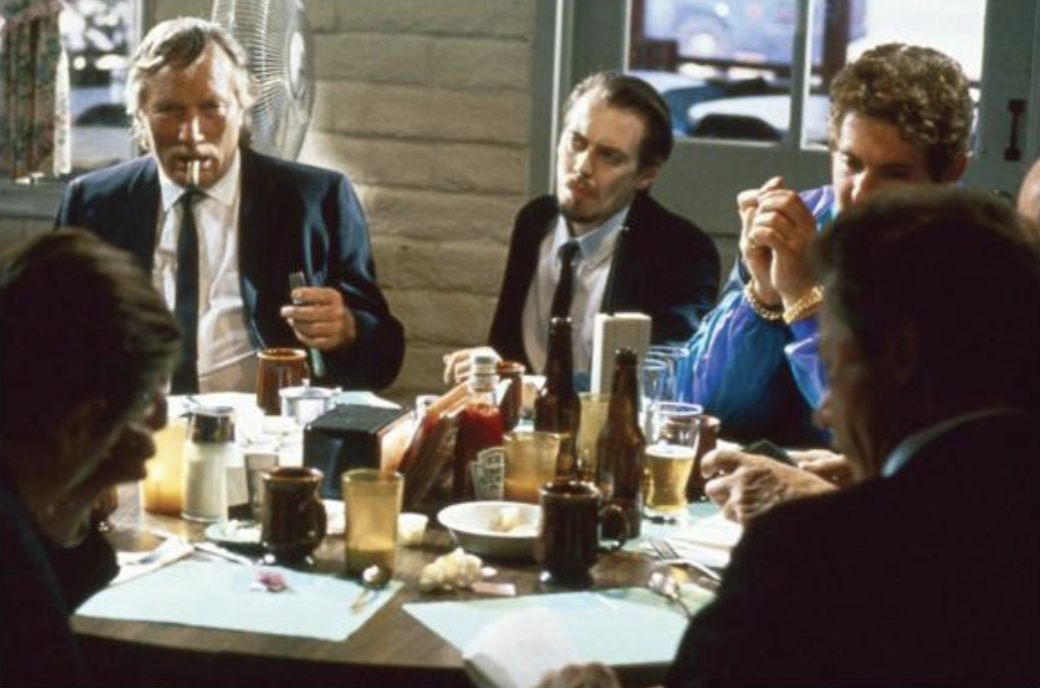By: Daniel Kilgallon, Staff Writer
The importance of developing intriguing characters through rich dialogue is a crucial part of crafting a quality screenplay for a movie. Very few writers in Hollywood today have mastered that skill, but Quentin Tarantino is absolutely part of the elite company. One of the greatest examples of this is the opening sequence of his first full length film,1992’s Reservoir Dogs. The roughly nine minute scene contains extensive dialogue, taking place exclusively around a breakfast table at a diner. Each of the characters featured are fleshed out through the words that they say, and if the audience pays close attention, it becomes apparent that they are actually setting the stage for the entire story as well.
For those who haven’t seen the contemporary cult classic, the plot of Reservoir Dogs revolves around a group of six gangsters who are recruited to perform a diamond heist by a crime lord named Joe Cabot (Lawrence Tierney) and his son, “Nice Guy Eddy” (Chris Penn). However, only a few names of the hired criminals are spoken throughout the film, as they primarily refer to one another by their assigned colors. For example, a vintage Steve Buscemi (who won’t tip) is only ever known as Mr. Pink, while Tarantino favorite Michael Madsen is typically called Mr. Blonde, but later revealed to be named Vic Vega (his brother Vincent was famously portrayed by John Travolta in 1994’s Pulp Fiction.)
As mentioned earlier, this exposition scene of Reservoir Dogs tells even more than meets the eye about the rest of the story to come. While I am not going to mention the exact details of the ending, I would not recommend reading past this paragraph if you have not had a chance to see the film in it’s entirety. It is amongst a handful of Tarantino-directed movies that seems to come and go from Netflix, so keep an eye out for it when you find yourself browsing around at night.
It is clear that every action and word of this screenplay was conceived with a purpose, which is a testament to Tarantino’s incredible attention to detail as a writer. Each gangster at the table gets their own moments to shine in the classic introduction, and everything about how they act in the diner coincides with their part in the ultimate story of the film. Harvey Keitel’s portrayal of Mr. White provides one great example of this and is perhaps the most clearly characterized member of the crew early on. During the seemingly simple diner conversation, he dismisses Mr. Brown’s interpretation of Madonna’s lyrics as meaningless, asserting himself as the first character to truly act like a professional.
White also displays a strong sense of leadership in the scene, as he is the only mobster to stand up to Joe Cabot’s kingpin character. He calls him out in front of everybody for obsessively flipping through an address book, which is a simple way for Tarantino to plant the idea of White being a protagonist into the minds of the audience. Throughout the rest of the story he continues to display heroic characteristics, is revealed to be a long-time partner of Joe via flashback, and defends Mr. Orange right up to the film’s final frame.
Mr. White is just one example of exceptional character writing by Tarantino here, but each and every gangster in this brilliant opening sequence are given the same treatment through the apparently simple actions and words of a table conversation. In doing this, a strong bond is created between audience and characters from the start, making the unique sequence of nonlinear events to follow a whole lot more impactful.

